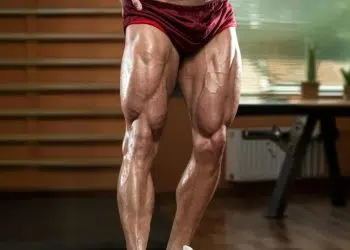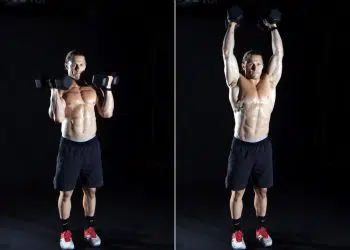The barbell curl, also known as the two-handed biceps curl, is a classic arm exercise. Known as a great mass builder, bodybuilders have been using this exercise for decades, if not centuries, to add size to their biceps.
But, while there is no denying that the barbell curl is a powerful exercise, it’s not the only way to build bigger arms.
In fact, if you become over-reliant on barbell curls, you could find that they start to lose some of their effect. After all, if you do the same old exercises over and over again, your muscles will eventually become accustomed to them, and your progress will grind to a halt.
Avoid biceps training ruts by using more than just barbell curls in your arm workouts. Here are the best barbell curl alternatives.
Top Barbell Curl Alternatives & Substitutes
Don’t get stuck in a barbell curl rut! Instead, add some much-needed variety to your arm workouts with these tried and tested alternatives.
1. EZ Bar Curls
While there is no denying the muscle-building power of the barbell curl, it’s also true that it can also cause elbow pain. Barbell curls lock you into a fully supinated (palms up) position that some lifters find uncomfortable.
Level Up Your Fitness: Join our 💪 strong community in Fitness Volt Newsletter. Get daily inspiration, expert-backed workouts, nutrition tips, the latest in strength sports, and the support you need to reach your goals. Subscribe for free!
EZ bar curls place your hands in a semi-supinated position, which takes pressure off your wrists and elbows. So, if straight bar curls bother your joints, try EZ bar curls instead.
Read more about EZ bar curls here.
2. Barbell Wall Curl
A lot of lifters cheat during barbell curls. They use their legs and backs to lift the weight, taking work away from the target muscle group – the biceps. Wall curls, also known as strict curls, eliminate the opportunity to cheat the weight up, making them a much purer biceps exercise.
Coincidently, this is also how biceps curls are done in powerlifting competitions. A few federations still include the strict curl as a supplementary lift alongside the more usual squat bench press and deadlift.
How to do it:
- Use a straight barbell or EZ bar as preferred.
- Hold the bar with an underhand, shoulder-width grip. Pull your shoulders down and back and brace your core.
- Lean your back against a wall or post/pillar.
- Starting with your arms straight and your back and butt against the wall, curl the bar up to your shoulders.
- Lower the bar and repeat.
- You can also do this exercise with dumbbells.
3. Barbell Power Curl
To the uninitiated, the power curl looks like you’re cheating. However, this exercise actually makes the most of an important neuromuscular phenomenon: you can lower more weight than you can lift. So, for this exercise, you purposely use your legs and back to raise the weight and then lower it under control.
This creates greater muscular overload, which could help build bigger, stronger biceps.
How to do it:
- Use a straight barbell or EZ bar as preferred.
- Hold the bar with an underhand, shoulder-width grip. Pull your shoulders down and back and brace your core. Stand with your feet hip to shoulder-width apart.
- Bend your knees slightly and lean forward from your hips. Lower the bar down to the middle of your thighs.
- Extend your hips and back and use this momentum to raise the weight to shoulder height.
- Lower the bar slowly, smoothly, and under control, and then repeat.
- This exercise works best using moderate to heavy weights and low to medium reps, e.g., 6-8 per set.
4. Seated Barbell Curl
The seated barbell curl is an unusual exercise. It emphasizes the top of your range of motion and creates an intense biceps contraction. It’s not necessarily better than regular barbell curls. Still, it’s different enough that it could be just what’s needed to keep you out of a biceps training rut.
How to do it:
- Sit upright on a bench with a barbell resting across your thighs. Hold the bar with an underhand, shoulder-width grip. Pull your shoulders down and back and brace your core.
- Without moving your torso any more than necessary, bend your arms and curl the weight up to your shoulders.
- Lower the bar back to your thighs and repeat.
5. Preacher Curl
Preacher curls were one of bodybuilder Larry Scott’s favorite exercises. In fact, preacher curls are so often associated with Scott that they’re sometimes called Scott curls. Larry Scott was the winner of the first two Mr. Olympia contests (1965, 1966) and was especially well known for his phenomenal arm development, which he attributed to his regular use of preacher curls.
There are several different preacher curl variations to try, including:
- Barbell preacher curls
- Dumbbell preacher curls
- Cable preacher curls
- Machine preacher curls
Each one keeps your upper arms stationary, so you cannot cheat the weight up. On the downside, you need a special bench to do preacher curls, although you can also do them by standing behind an inclined workout bench.
6. Spider Curl
Spider curls are similar to preacher curls. However, you don’t need a special bench to do them. Like preacher curls, they all but eliminate momentum and cheating, making them a pure biceps exercise. This is a good option for anyone who finds it hard not to use their legs or back during biceps curls.
Learn how to do spider curls here.
7. Alternating Dumbbell Curl
Barbell curls involve one function of the biceps – elbow flexion. Using dumbbells means you can also involve the second function of the biceps: supination of the forearm. Using an alternating arm action is also useful for strengthening your mind-muscle connection, as you are free to focus on one arm at a time.
How to do it:
- Hold a dumbbell in each hand and sit or stand as preferred. Pull your shoulders down and back and brace your core. Your palms should be facing inward, i.e., a neutral grip.
- Bend one arm and curl the weight up toward your shoulder. As your forearm nears parallel to the floor, rotate your wrist, so your palm is uppermost.
- Lower the weight using the same action but in reverse.
- Switch arms and repeat.
- Alternate arms for the duration of your set.
8. Incline Dumbbell Curl
Incline dumbbell curls put your arms in a stretched position at the start of each rep. This changes the feel of the exercise and also makes it harder than doing curls with a more upright torso. As such, you won’t be able to go very heavy when you do this exercise, but that doesn’t make this exercise any less effective.
Level Up Your Fitness: Join our 💪 strong community in Fitness Volt Newsletter. Get daily inspiration, expert-backed workouts, nutrition tips, the latest in strength sports, and the support you need to reach your goals. Subscribe for free!
Read more about incline dumbbell curls here.
9. Bayesian Cable Curls
This exercise is the cable equivalent of incline dumbbell curls. It stretches your biceps and extends your shoulder, increasing biceps activation in the process. Using a cable also keeps your biceps under constant tension, which may increase muscle recruitment for a more effective workout. No cable machine? That’s no problem! You can also do this exercise with a resistance band.
How to do it:
- Attach a D-handle to a low pulley machine. Grab the handle and stand in a split stance with your back to the weight stack. Brace your abs. Extend your arm behind you.
- Bend your elbow and curl the handle forward and up toward your shoulder.
- Extend your arm, getting a good mid-rep stretch, and repeat.
- Do the same number of reps on each side.
10. Dumbbell Concentration Curl
According to the American Council on Exercise (ACE), dumbbell concentration curls are THE best biceps exercise for muscle activation (1). However, that doesn’t mean you should quit doing every other biceps exercise, but it does suggest they deserve a place in your workouts.
Concentration curls are best done with light to medium weights and moderate to high reps. Chase that pump rather than try and hoist heavy weights.
Learn how to do dumbbell concentration curls correctly here.
11. Cable Curl
If freeweight exercises have a disadvantage, it is that the tension on your muscles changes depending on the position of the weight. In contrast, cable exercises tend to keep your muscles under constant tension, which may be better for muscle hypertrophy or growth.
You can do cable curls with a straight bar, EZ bar, or rope handle as preferred.
How to do it:
- Attach your chosen handle to a low pulley machine. Grab the handle and stand with your feet about shoulder-width apart, shoulders down and back, and core braced. Your arms should be straight.
- Bend your elbows and curl the handle up to your shoulders, squeezing your biceps at the top of each rep.
- Extend your arms, lower the handle, and repeat.
12. Supine Cable Curl
Like curls against a wall, this exercise all but eliminates any chance of cheating. As such, it’s a very pure biceps exercise and also very lower back-friendly. You can do this exercise using an EZ bar, straight bar, or rope handle as preferred.
How to do it:
- Attach your chosen handle to a low cable machine. Sit on the floor with your feet against the bottom of the machine.
- Hold the handle with a shoulder-width underhand grip. Lie down flat on the floor with your arms straight, core braced, and shoulders down and back.
- Keeping your elbows close to your sides, bend your arms and curl the handle up to your shoulders.
- Extend your arms and repeat.
- Continue for the prescribed number of reps.
13. Zottman Curl
Zottman curls, named after strongman George Zottman, are an old-school biceps exercise. They work the biceps brachii, brachialis, and brachioradialis, making them ideal for when you want a complete biceps workout but only have time for one exercise.
How to do it:
- Sit on an upright exercise bench or stand with your feet shoulder-width apart and knees slightly bent for balance. Hold a dumbbell in each hand by your sides, palms facing your legs. Make sure your torso is fully upright. Brace your abs.
- While keeping your upper arms close to your sides, bend your elbows and curl the weights up to your shoulders. Rotate your wrists to turn your palms upward as you raise the weights. Curl the weights all the way up until your biceps are fully contracted.
- Next, without lowering the weights, rotate your forearms so your palms are now facing downward. This is called a pronated grip.
- Extend your arms and lower the weights down towards the starting position while keeping your hands pronated.
- As the dumbbells near your legs rotate your wrists, so your palms face inward – a neutral grip.
- Repeat for the prescribed number of repetitions.
14. Chin-ups
Chin-ups are typically viewed as a lat exercise. Still, they’re also an excellent biceps builder and a decent alternative to barbell curls. In fact, if you take a look at what your arms are doing during chin-ups, you’ll soon see that the movement is a lot like barbell curls, except you’re curling your shoulders up to the bar instead of the bar up to your shoulders.
It’s good to know you can build your biceps using nothing more than your body weight!
How to do it:
- Hold an overhead bar with an underhand, shoulder-width grip. Hang with your arms straight and feet clear of the floor. Brace your core and pull your shoulders down and back.
- Bend your arms and pull your chin up and over the bar. Drive your elbows down and back as you ascend.
- Slowly lower yourself back down until your arms are straight, and then repeat. Do not relax between reps, and don’t use your legs to kick yourself up.
15. Suspension Trainer Biceps Curl
Suspension trainers like the TRX are great for on-the-go workouts. Light and portable, you can take a suspension trainer with you wherever you go. They’re perfect for outdoor workouts where taking weights would be impractical. You can use a suspension trainer to work your entire body, and suspension trainer biceps curls are an especially good exercise. But, of course, you’ll need a suspension trainer to do them!
How to do it:
- Attach the cables to an anchor point above your head. Adjust the straps to hang down at about waist height.
- Grab the handles and stand with your body facing the anchor point. Walk your feet toward the anchor point and lean back, keeping your core tight. The further back you lean, the harder this exercise becomes, so adjust your feet accordingly.
- Starting with your arms straight, bend your elbows and curl your forehead toward the handles. Keep your body straight and your core tight throughout.
- Extend your arms and slowly lower your body back towards the floor until your arms are straight.
16. Plate Curl
No barbell? No dumbbells? No cable machine? No problem! You can build your biceps with nothing more than a weight plate. Plate curls are a lot like hammer curls, so, as well as working your biceps, they also strongly involve your brachialis and brachioradialis, which are two similarly important arm muscles.
How to do it:
- Stand with your feet shoulder-width apart. Bend your knees slightly for balance, pull your shoulders down and back, and brace your core. Hold a weight plate, so your hands are directly opposite one another, i.e., the “quarter to three” position.
- With your upper arms tucked in close to your sides, bend your arms and curl the weight plate up to your chest. Resist the temptation to use your legs or back to help you swing the weight up.
- Lower the weight plate back down, making sure you control the descent, until your arms are straight, and continue for the desired number of reps.
More Alternative Exercises:
- EZ Bar Curl Alternatives
- Spider Curl Alternatives for Bigger, Stronger Biceps
- Preacher Curl Alternatives for Bigger Biceps
- Pec Deck Alternatives for an Awesome Chest
- Best Bench Press Alternatives
- Best Back Extension Alternatives
- Best Cable Crossover Alternatives
- Triceps Pushdown Alternatives
- Power Clean Alternatives
- Best Face Pull Alternatives
Barbell Curl Alternatives – Wrapping Up
In the same way that squats are the king of leg exercises, barbell curls are the king of biceps exercises. In fact, it’s hard to think of even a single successful bodybuilder that hasn’t done barbell curls in pursuit of bigger, more muscular arms.
That said, you can have too much of a good thing, and while barbell curls can be effective, they could lose their potency if you do them too often.
So, shake up your biceps workouts with any of these barbell curl alternatives. Each one is every bit as good as barbell curls but also different enough to keep you out of any potential training ruts.
Don’t feel you need to drop barbell curls completely from your workouts but do supplement them with a couple of exercises from this list. Hit your biceps from different angles using a range of exercises to build arms you can truly be proud of!
References:
1 – American Council on Exercise (ACE): ACE Study Reveals Best Biceps Exercises https://www.acefitness.org
Interested in measuring your progress? Check out our strength standards for Bench Press, Face Pull, Barbell Curl, and more.








